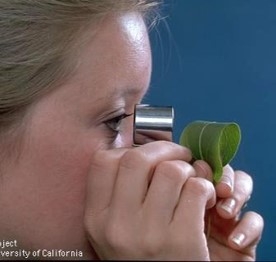
The first factor in the disease triangle to evaluate is the host plant. Know what a healthy plant looks like-- both its aboveground portions and roots-- so that abnormalities can be recognized. Identify the plant species or cultivars that the unknown disease is occurring on. Look for patterns where abnormalities are occurring. Are there certain species or many species? Are there patterns that could suggest abnormalities caused by abiotic factors such as excesses in temperature, light, fertilizer, or pesticide application?
The second factor is the pathogen. Identifying biotic diseases is sometimes facilitated if the pathogen is visible. Particularly with some fungi, distinctive mycelium and spores can be visible on diseased tissue. Sometimes the pathogen can be seen with the naked eye but sometimes a hand lens can aid in seeing them. Gray mold (Botrytis), powdery mildews, and rusts are good examples of diseases that have distinctive spores and mycelium that are usually quite visible. Often, however, diseased tissue must be cultured in the laboratory to get the pathogen to produce mycelium, spores, or spore-producing structures that could aid identification. A light microscope can help the plant pathologist see and identify the specific pathogen in the laboratory. With viruses or other similar microscopic pathogens an electron microscope is needed to see and identify the pathogen. Sometimes evidence of a secondary fungus, bacteria or insect is visible and not directly related to the primary cause of disease.
The third factor is the environment. The diagnostician can collect information on the environmental conditions associated with the disease. Does irrigation frequency, dew, greenhouse condensation support disease occurrence? Do temperatures support the pathogen? Have temperatures been excessively high or low for plant growth? Have there been excesses applied of fertilizer, soil amendments, or pesticides that have been associated with the occurrence of disease?
References that aid in the diagnostic process are often organized so that they use and describe these three factors. To use these references, you need to first identify the host plant. After host identification, you can often go to a section where the host plant's common diseases are listed. The disease symptoms are described along with a description of the pathogen's mycelium, spores, or spore producing structures. There usually is a description of the specific disease's life cycle and any environmental conditions that support infection and development of a disease. Together, the information helps to focus the diagnostic process and formulate a likely diagnosis of an unknown plant disease.
Next: Suggested references that aid in identifying diseases and pests of ornamental plants.
For a more comprehensive look at the diagnostic process see attachment below:
Attached Files: